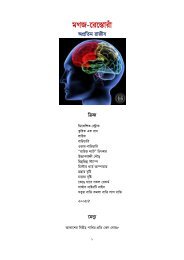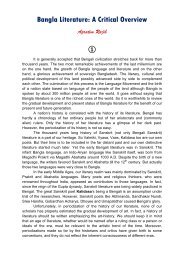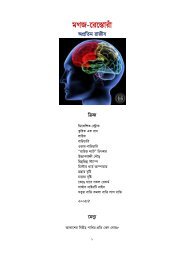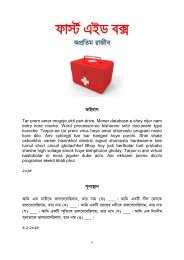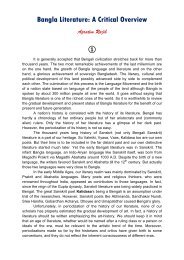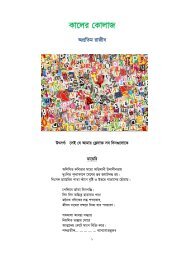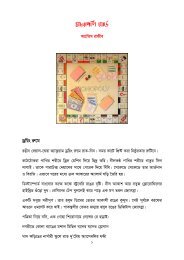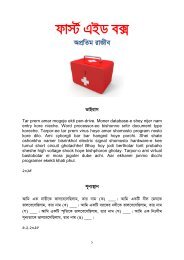BLiterature-Apratim
You also want an ePaper? Increase the reach of your titles
YUMPU automatically turns print PDFs into web optimized ePapers that Google loves.
36<br />
His early attempt Devdas, although poor in structure, gives a little hint to his<br />
progressive and revolutionary mind. It is the story of a young man who dies out of<br />
anguish for his fatal love-affair. His Palli-Samaj (Country-Society) is a good portrayal<br />
of an unconsummated love-affair in Bengal’s rural society.<br />
Arakshaniya (The Eligible Girl) is the story of a girl of dark complexion, whose<br />
mother finds it too difficult to marry her off. It results in her pitiable humiliation in the<br />
society. This novel questions the anachronistic values of the heartless society that<br />
considers physical beauty (and fair complexion) a must for the female.<br />
Chandranath is the story of another girl’s disgrace – this time, for being a<br />
‘dishonest’ mother’s daughter.<br />
Charitrahin (The Characterless) questions the character of a society itself<br />
which suppresses its members’ carnal desires due to traditional and outdated<br />
concepts. It tells us two stories alongside; one of them is of a love-affair between a<br />
babu and her maidservant; the other tale is of a similar relationship of a widow and<br />
her distant brother-in-law. The first one ends in the beloved’s disapproval of a<br />
possible marriage (as she honors the class divide) and the other relationship ends in<br />
tragic consequences as the widow loses her mind.<br />
Grihadaha (Burning of the House) suspects the very existence of a society<br />
which finds itself helpless while perverted and contaminated by the betrayal of its<br />
dishonest members. Here Sarat shows how marital bond loosens for economic<br />
inequality amid a man, his wife’s parental home and her extramarital lover. In it he<br />
masterly depicts illicit love and its consummation through adultery by a lustful man<br />
(Suresh) and his friend’s (Mahim) disloyal wife (Achala). At the same time the writer<br />
portrays the conflict between emotional love and physical impulse. However, with<br />
due apology to his memory, I convict him of corruption in this context; the reason is:<br />
he does not give the reader any scene of intimate relationship between Achala and<br />
her husband Mahim, which he does in case of her and her lover Suresh. Does Sarat<br />
make this bias for commercial accomplishment?<br />
Marital bond loosens due to economic difficulties in Birajbou too. This novel is<br />
also a mirror of physical persecution on those days’ Bengali women. A village<br />
housewife, who is devoted to her husband, endures long days’ poverty and<br />
persecution with great patience, a virtue which those days’ Bengali Hindu women<br />
were believed to must have. Excessive torture forces her leave her in-laws’ house for<br />
what she later repents.<br />
Sarat professes his firm belief of the insignificance of marital bond in Shesh<br />
Prashna (The Last Question). Love, if is based on trust, loyalty and sincerity, does<br />
not need social approval; it is this novel’s motto.<br />
Many of his works focus on family values, for example – Shuvoda, Bamuner<br />
Meye (A Brahmin’s Daughter) etc. Datta is a love story where the writer prefers the<br />
choice of heart to formal socio-religious convention. And his Pather Dabi (The Claim<br />
of the Road) is a political novel that was banned by the British government.<br />
But he excelled in Sreekanta which is regarded as a great picaresque novel. It<br />
is the story of a vagabond man (a writer), observing the complexities of the Bengali<br />
Hindu middle class society and commenting about those in first person narrative. In<br />
reality, Sarat himself appears as Sreekanta as this work is recognized by him as an




